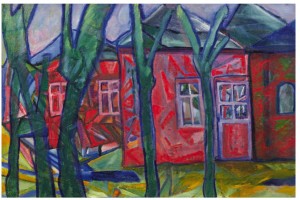The art styles which we call expressionism or neo-expressionism are elements of a different culture, a culture in which it is as impossible to negotiate the meaning of art as it is to negotiate the meaning of man, his life, intentions or language. Like humanity itself, art is not a mere convention; it is an inquiry into freedom. It is not a contract but a question of necessity.
In the 20th century, thinking of art as external to social contract meant destroying the modern world’s systems of communication. This is how certain nonexistent planes of the world are portrayed in Fedor Semenov-Amursky’s landscapes of heavenly gardens near Zvenigorod and Leonid Zusman’s paintings of the narrow side streets of Moscow, a world that was ever contemplating, ever reading, ever feeling, a world yet alive but already passing, with no hope of deliverance. This is how Anton Chirkov’s language of painting is born before the beholder’s very eyes, a language that emerges from terrible muteness and non-existence in suffering; the artist cannot even think of somehow embellishing this idiom. He is left one-onone with “art”, with that which occurs “apart from his will”. He is not worried about whether he will be understood correctly. And that is how it always happens; that is how art comes into being. There are always languages which communal culture refuses to speak, languages in which the unrealized present is realized.
This is the space in which Moscow’s ever frozen winters exist, about which Andrei Belyi wrote, “ ’Twas the fourth day that, like shrill specters, arms raised, they continued their madcap rush along the streets; and like specters, the phantoms tormented the grey pedestrians.” [18] The world on which the poet is casting his spell will never come into being, and can never speak this language. It will never comprehend that in its encounter with this language, it will suffer one of those defeats that will bring it to life. “It seems as though block after block of Moscow is being broken off, pulverized into smithereens and flung up by the whizzing and glittering into an uninterrupted rustle, wham, bam!” [19]
This is the space in which the stories told by Venedikt Yerofeyev take place every day: “They plunged an awl right into my throat … I had never imagined that such suffering could exist. I writhed from the excruciating pain as a thick, red, quivering blotch covered my eyes. I have not regained consciousness since that day, and never will.” [20]
The poetic tradition of maintaining language as a system of esoteric knowledge remained alive in Russia right up to the 1980s. The experience of poetic speech as something mystical was passed down from Gogol to Velimir Khlebnikov, Alexander Blok, Andrei Belyi, Boris Pasternak, Mikhail Bulgakov, Nikolai Zabolotsky and, finally, to Venedikt Yerofeyev. From this same cultural phenomenon stems the orphic direction of art in the works of Magdalina Verigo, Sergei Romanovich, Yekaterina Belyakova and Anton Chirkov. In their works, the language of painting is still maintained not only as a form for expressing distinctive states of the world’s being, but also as a way of getting to know the world and a repository for this knowledge.




Капитановский Александр
25 Aug 2012
Встретил Ваши тексты, прежде не довелось. Теперь читаю. С благодарностью и уважением.